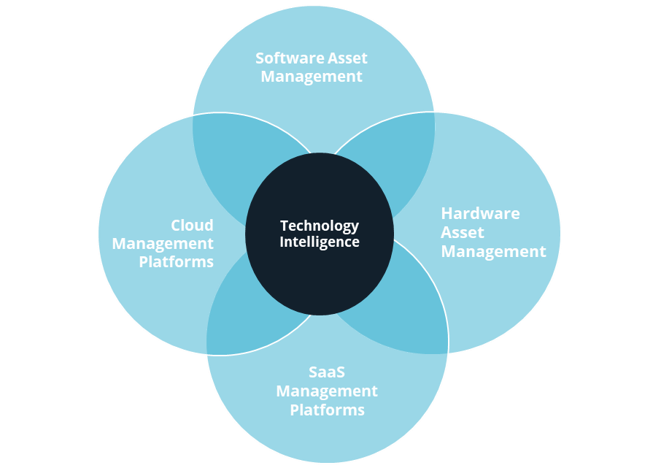The Convergence of Cloud Management and SAM

It wasn’t that long ago that a software asset manager’s job wasn’t quite as complex as it is now. Desktop deployments were the primary concern and ensuring compliance with software licensing terms, while certainly not easy, was reasonably straightforward once the necessary data was gathered. The cloud has fundamentally shifted and grown the responsibilities and mandate of software asset management (SAM).
There are a few points that highlight both the risks and opportunities cloud deployment presents:
- Why effective SAM includes cloud
- By their nature, cloud services introduce cost control challenges
- Cost optimization is only possible with broad visibility across environments
SAM includes cloud services, and is better off for it
There are still a small number of SAM leaders that feel cloud doesn’t fall under their remit. But beyond semantic definitions and ISO/IEC categorization, effective SAM leaders have recognized that in order to provide value to their organization, they must consider cloud services. Let’s look at just a few of the areas where SAM and asset data can provide value:
- Digital transformation
- Cloud migration
- Mergers and acquisitions
- Contract negotiations
- Cybersecurity
- Compliance regulations
But value can’t be provided to these areas without incorporating usage and cost data for cloud services. Without considering public cloud, organizations aren’t able to track the shift from on-premises to cloud, don’t have complete visibility into technology spend, and aren’t ready for new and varied challenges cloud brings to security and compliance.
As compliance concerns wane, cost challenges grow
While being out of compliance in the cloud is still possible—especially when using on-premises entitlements in public cloud environments—it is less of a concern than when desktop deployments dominated the enterprise. But as this concern lessens, another grows: controlling costs. There are a few primary reasons for this:
- Decentralized IT purchasing. Cloud adoption has enabled a shift from IT to business units as the primary decision-maker of technology purchases. Today, approximately 40% of technology is bought outside of IT with some analysts predicting this will grow to 80% within the next three years. Arguably this has made organizations more agile and—hopefully—more innovative, the free-for-all use of applications is translating into less visibility for IT and SAM practitioners into what technology is being consumed. This lack of visibility inhibits IT’s ability to manage, control, and predict costs.
- Ease of use. The very thing that makes cloud services so attractive, the ability to easily procure and consume them, is what makes them ripe for wasteful consumption. Development, support, services, and other teams can spin up VMs, often with little to no governance.
- Pay as you go license models. For the most part, cloud vendors charge based on how much they are used. While this certainly has an appeal, without governance, organizations can find themselves paying for underutilized or forgotten environments, driving significant wasted spend.
“By 2020, eliminating the “toxic” consumption of “PaaS” and “IaaS” will become a high-priority focus of SAM discipline for 50% of organizations.2”
Based on my conversations with SAM and IT leaders, Gartner’s prediction of a few years ago has certainly come to pass. Organizations are struggling with cloud cost containment. Fortunately, with the right solutions, processes, and perspective in place, effective management is possible.
Broad visibility of assets and usage enables cost control
Snow recently introduced its Technology Intelligence vision (below) to capture the growing scope of technologies that asset managers must consider. We recognize that while we might still sometimes refer to our discipline as SAM, traditional software is only one part of the equation within the increasingly complex IT landscape. IT leaders and SAM practitioners must now account for on-premises, IaaS, SaaS, and hardware.

Importantly, across all of these environments, a critical aspect is the ability to capture usage data. With cloud services usage data, a SAM leader can begin to truly understand and manage costs. Just a few examples of what is possible within the realm of public cloud include:
- By monitoring utilization of CPU and memory in virtual machines, organizations can optimize how much they buy from cloud vendors, rightsizing instances and significantly reducing costs
- Scanning for discarded “zombie VMs” that are no longer needed enables IT to deprovision these instances
- Establishing effective cost tagging creates an environment and culture of cost visibility, helping departments self-enforce their own usage
Closing Thoughts
Two years ago, Gartner said of SAM, “Market Penetration is low today – between 1 and 5% of the target audience, despite the many benefits that can be achieved by implementing SAM tools”1. While adoption has certainly grown in the past two years, most organizations still have not taken advantage of SAM and asset management solutions. My prediction is that the explosion of cloud services usage will create an opportunity and a justification for organizations to realize the value these solutions can bring, especially in the area of cost management.
For more insight on cloud management, download your copy of the latest 2020 Gartner Magic Quadrant for Cloud Management Platforms.
1 Gartner, Emerging Technology Analysis; Software Asset Management Tools, April Adams, Roger Williams, March 5, 2018.
2 Gartner, Predicts 2018: Mature Your IT Asset Management Discipline to Deliver on the Promise of Digital Business, Yanni Karalis, Tim Zimmerman, Stephen White, Roger Williams, Bart Willemsen, December 12, 2017.